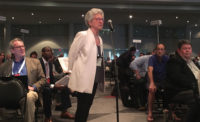Beyond Trump and Clinton
Editorial: The High Costs of Sexual Harassment in Construction
Why So Few Women Work in Engineering and Construction
Sexual harassment and predation have overshadowed many of the traditional issues during this year’s contest for the U.S. presidency between Hillary Clinton and Donald Trump. While it would be wrong to suggest that sexual harassment is the main reason construction employs so few women—frequent relocation, inadequate family or maternity leave, and flex-hour policies play a role—it would be equally wrong to rule it out. This is a good time to review the costs.
Women remain woefully underrepresented in construction. Overall, they account for less than one out of 10 people employed in any kind of construction job, according to the U.S. Dept. of Commerce. Construction trades, where women account for only about 2.6% of staff, lag even further behind. All together, this has heavy repercussions for the industry and the economy as a whole. For example, once a woman is employed in construction, she is likely to earn only about eight dollars for every 10 that a man makes. Ironically, that is a much smaller pay gap than in other industries and a bigger incentive than ever for a woman to embark on a construction career.
Although construction can be a path to economic security and independence for women and the families they support, the rate of sexual harassment charges brought per 100,000 workers is among the highest of any business sector.
The typical victim of harassment in any industry is a woman between the ages of 25 and 45, and the typical harasser is a male in a higher position at the organization or in a supervisory role on a jobsite or in an office. Besides the emotional scars it inflicts, sexual harassment depresses the victim’s productivity and triggers more days taken for sick leave. Victims are more likely to quit, as well.
Engineering degrees provide a vital career path into construction, and percentages for women enrolling in and graduating from degree programs are getting higher. But a 2012 National Science Foundation-funded survey reported that only six out of 10 women who graduate with engineering degrees stay in the profession. More recent studies have shown that the exiting women engineers departed because of an “organization climate,” which includes non-supportive supervisors and co-workers and “general incivility.” Others cited frequent travel, few opportunities to advance and low pay.
Construction no longer is exclusively a man’s club. Yet, working conditions can still spur a discouraging trepidation. Not surprisingly, in the education and health sector, where women account for three out of four people employed, the rate of harassment complaints is among the lowest.
This suggests an obvious solution: More women in the office and in the field will create a network of support that will lead to less sexual harassment in the construction industry, which, in turn, will draw more women to construction, engineering and the crafts, where they are badly needed. It is as simple as making good-faith efforts to hire talented women, building policies to retain them and never giving harassment a pass.



